国際活動
当科は順天堂大学の三無主義「性別・学閥・国籍を問わず」実践しています。医局員の半数は女性であり結婚出産後も大活躍しています。出身大学で分け隔てしない順天堂はとても働きやすく、当科科長も他大学出身で18年順天堂に勤務しています。さらに当科では国際活動に力を入れています。外国籍の医局員、 海外留学への道(2023年臨床留学オーストラリア・カナダ計3人 基礎留学アメリカ1人)や海外留学生受け入れ(医学生、レジデント、 大学院生、 研究生)を積極的に行っています。
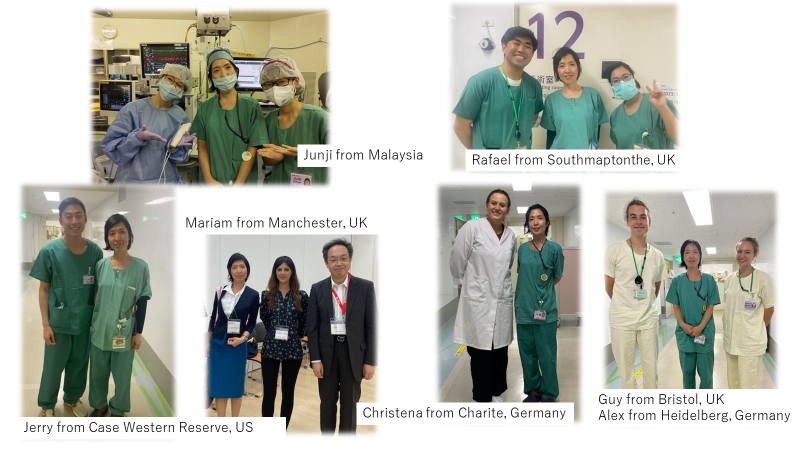
順天堂国際交流センターのObservational Programのホストとして、 医学生やレジデントを2-12週間単位で受け入れています。それゆえ医局には常に外国人留学生がいます。時期によっては一緒に学会にも行ったりもしています。(写真)最近では留学生同士の口コミから「順天堂麻酔科」の人気が高まり応募者多数になっているのでイギリス、 アメリカ、 オーストラリアなど母国語が英語の生徒が多くなっています。UKのBristolやManchester、 ドイツのHeidelberg、 Chariteからは5-6年生の優秀な留学生が毎年1-2名ずつ訪れていますObservational Programはコロナ禍で中断していましたが2022年6月から現在までに19人受け入れており、 2024年3月までさらに4人受け入れる予定です。2022年夏にはウクライナ支援として麻酔科専攻医受け入れ(2人×3か月)ていました。
 Brigham and Women's HospitalからのResident (Christoph)と
Brigham and Women's HospitalからのResident (Christoph)とHeidelberg UniversityからのStudent (Helen)
また、 昨年から米国の最高峰麻酔科研修病院であるBrigham and Women’s Hospitalから麻酔科志望のレジデントを1か月間受け入れています。本国での研修単位とみなされることが認証され今後も継続していく予定です。(写真)。留学に行かなくても医学を通した国際感覚に慣れ親しむことができます。科長の専門は胸部麻酔であり、ヨーロッパ心臓胸部麻酔学会(EACTAIC)の委員を務めています。欧米の潮流を医局にいち早く取り入れることはもちろん、 自身がヨーロッパで行っている講演やワークショップと同じ教育を医局で行っています。(写真)ヨーロッパの施設と国際共同研究も行っています。
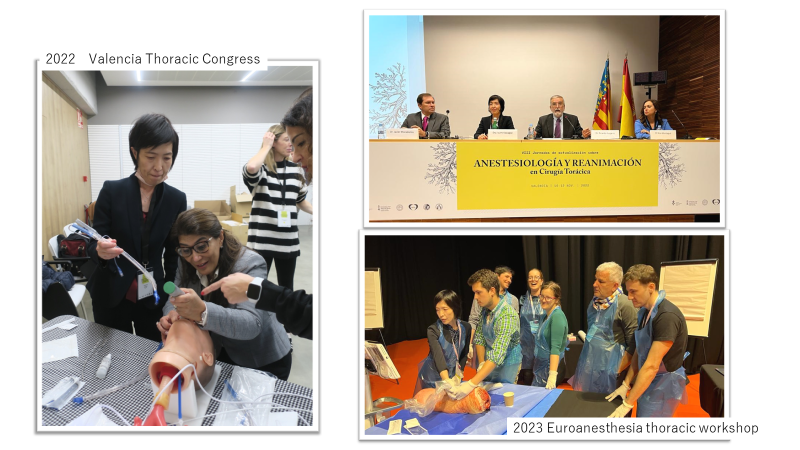
もちろん,医局員の国際学会の発表や英文国際雑誌への投稿も全力でお手伝いしています。
国際活動などに興味がある先生は是非見学やご連絡をお待ちしています。
国際活動などに興味がある先生は是非見学やご連絡をお待ちしています。
報告
- Hospital Kuala Lumpurの先生が研修しました
-
Nurtushila Abd Malek
研修期間:9月2日~9月12日
所属: Hospital Kuala Lumpur
国籍:マレーシア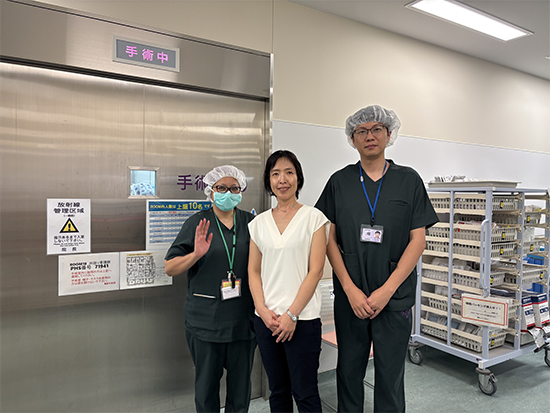 Shila先生 川越教授 周先生Professor Izumi Kawagoe was personally recommended to me by a senior cardiothoracic consultant in Malaysia after I was offered by the Ministry of Health Malaysia for an Advanced Competency Programme in Thoracic Anaesthesia. An instant and enthusiastic reply by Prof Izumi convinced me that this will indeed be a fruitful and an enriching experience for me. The orientation was a seamless process by the JUIC personnel, and I was greeted by Prof’s secretary day after to guide me to the Anaesthesia department and OT changing room.
Shila先生 川越教授 周先生Professor Izumi Kawagoe was personally recommended to me by a senior cardiothoracic consultant in Malaysia after I was offered by the Ministry of Health Malaysia for an Advanced Competency Programme in Thoracic Anaesthesia. An instant and enthusiastic reply by Prof Izumi convinced me that this will indeed be a fruitful and an enriching experience for me. The orientation was a seamless process by the JUIC personnel, and I was greeted by Prof’s secretary day after to guide me to the Anaesthesia department and OT changing room.
I was immensely impressed with the state-of-the-art Operating Rooms equipped with advanced technology surgical and anaesthetic equipment. The work culture for Japanese doctors is truly admirable that reflects efficiency, competence and orderliness. The staffs also exhibit high degree of professionalism with minimal casual conversation and screen time, and they also put great emphasis in patient’s comfort in the OR. The interpersonal communication between the anaesthetist, surgeons and nurses is a sight to behold as they often demonstrate respect and courtesy towards each other. The Japanese patients in general resemble “model” patients as they are frequently thinner and more resilient while undergoing procedures pre-anaesthesia induction.
I personally learn various tips and tricks in the management of anaesthesia for thoracic surgical patients under the guidance of Prof Izumi and other anaesthetists. I truly enjoy my 2 weeks attachment in this department and will apply the acquired knowledge in my home country.
マレーシア保健省から胸部麻酔の高度専門研修プログラムへの参加を打診された後、マレーシアの心臓胸部外科の上級コンサルタントから川越いづみ教授を個人的に推薦されました。川越教授の即座かつ熱心な回答に、この研修が私にとって実り豊かで充実した経験となることを確信しました。
JUIC職員によるオリエンテーションは滞りなく進められ、翌日には教授の秘書の方が迎えてくれ、麻酔科と手術室の更衣室まで案内してくれました。
最先端の手術室には最先端の手術機器と麻酔機器が備えられており、大変感銘を受けました。日本の医師の職場文化は、効率性、技術や能力、そして秩序を重んじる、実に素晴らしいものです。スタッフは、患者の前では日常会話やカルテやPCに向き合う時間を最小限に抑えるといった高いプロ意識をもち、手術室における患者の快適さにも細心の注意を払っています。麻酔科医、外科医、看護師の間の関係は、随所に互いへの敬意と礼儀が自然に溢れていて、見事です。また、日本の患者さんはみんな痩せていて、麻酔導入前の処置を受けている間も騒いだりせず、まるで「模擬患者」のようでした。
私自身も、川越教授をはじめとする麻酔科医の指導の下、胸部外科患者の麻酔管理に関する様々なヒントやコツを学びました。この科での2週間の研修は本当に有意義で、母国でもこの知識を活かしていきたいと思っています。
(自動翻訳+α)
- Angla Ruskin Universityの医学生が研修しました
-
Sonia Cherid
研修期間:2025年7月29日~8月1日
所属:Angla Ruskin University 医学部 5年
国籍:イギリス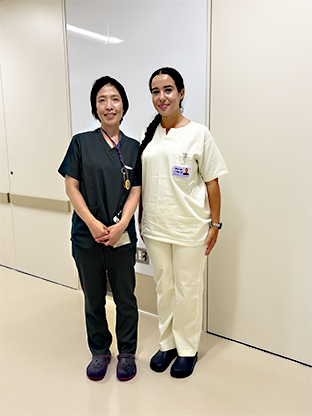 I completed a one week observership.
I completed a one week observership.
With anaesthesiology department in Juntendo University Hospital where I met Kawagoe sensei who kindly informed the department of my arrival, showed me how to check the surgeries for the day and allowed me to freely chose what I wanted to see in the day based on my interests which allowed me to shadowed many different anaesthetists in all kinds of surgeries so I had the opportunity to observe many diffferent specialties at work such as cardiology watching mitral vale prolapse repair and cry ablation for atrial fibrillation, thoracic surgeries using the Da Vinci robot surgery to remove lung cancer and Caesarean sections. I was also afforded the opportunity to observe some anaesthetic procedures such as paravertebral nerve block, thoracic epidurals and spinal injections for Caesarean sections. I learned about the prevalence of single lung ventilation in Japan and how it can be used effectively in the thoracic cases. I was able to observe and understand the difference between the Japanese and UK healthcare systems.
All of the anaesthesiologists I encountered went out of their way to translate and explain what each surgery was and what was happening as well as teaching me about the anaesthetic drugs and answering all of my questions in detail to help me better my understanding. It was an amazing opportunity and experience I highly recommend an observership in this department.
順天堂大学病院麻酔科で1週間のオブザーバーシップを終えました。
そこで川越先生にお会いし、私の到着を麻酔科に伝えていただき、その日の手術の確認方法を教えていただきました。また、自分の興味に合わせて自由に見学することができました。おかげで、様々な麻酔科医の様々な手術を見学することができました。心臓病学では僧帽弁逸脱症の修復や心房細動のCRYアブレーション、ダヴィンチロボットを用いた肺がん摘出手術、帝王切開など、様々な専門分野の仕事を見学する機会に恵まれました。また、傍脊髄神経ブロック、胸部硬膜外麻酔、帝王切開における脊髄麻酔などの麻酔処置も見学する機会に恵まれました。日本における片肺換気の普及状況と、それが胸部手術においてどのように効果的に使用されるかについて学びました。日本と英国の医療制度の違いを実際に観察し、理解することができました。私が出会った麻酔科医は皆、それぞれの手術の内容や手術中に何が起こるのかを丁寧に翻訳・説明してくれました。麻酔薬についても教えてくれ、私の質問にも丁寧に答えて理解を深めてくれました。素晴らしい機会と経験でした。この科でのオブザーバーシップはぜひお勧めします。(自動翻訳)
- University of ManchesterとUniversity of Cambridgeの医学生が研修しました
-
Himesh Bipin Patel
研修期間:2025年6月10日~6月20日
所属:University of Manchester医学部4年
国籍:イギリス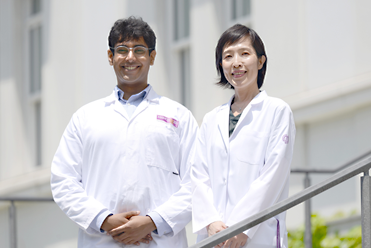 I wish I had spent more than two weeks here to continue learning under these doctors’ guidance as they tackled diverse and challenging cases such as Kidney Transplants and rare Neonate andPaediatriccases. I found the Attendings’ desires to get their juniors and residents involved as much as possible, even in these complex cases, refreshing and inspiring.
I wish I had spent more than two weeks here to continue learning under these doctors’ guidance as they tackled diverse and challenging cases such as Kidney Transplants and rare Neonate andPaediatriccases. I found the Attendings’ desires to get their juniors and residents involved as much as possible, even in these complex cases, refreshing and inspiring.
I had a short visit to ICU, CCU, and HDU for a couple of days which was insightful, the ICU experience differs a lot to that back in the UK where Juntendo ICU patients are largely post-op patients who only stay for a short time.
As I rotated in Early June, there were only a few Juntendo University Students rotating towards the end of their timetabled blocks before an exam break. I had only just got used to communicating with my broken Japanese and trusty translator app before I had to leave, but for the short time, I found students welcoming and often taking extra time to translate what an instructor had explained to them back to me.
I would love to return to this department in any capacity and look forward to hearing future Manchester students’ experiences here!
Thank you!"川越いづみ教授が率いる麻酔科とペインメディスンの部門は非常に魅力的で、チームを信頼する医師たちによって研修医や後輩の学びを加速する文化が育まれています。私はまた、麻酔チームの主要なメンバーに非常によく紹介されたと感じており、すぐにローテーションを始めて関与することができました!私がそこにいる間、選ばれた国際研修医で研究者であるシュウ先生、ジョシュア・リー先生、レイ先生に恵まれました。彼らは麻酔を日本、英国、アメリカ、そして中国で実践することについての反省や比較を翻訳し議論するために尽力してくれました。
ここで2週間以上過ごして、腎移植や珍しい新生児および小児の症例など、さまざまな挑戦的なケースに取り組むこれらの医師の指導の下で学び続けたかったです。指導医たちが、こうした複雑なケースでも、できるだけ多くの後輩や研修医を巻き込もうとする姿勢は新鮮で、インスピレーションを与えてくれました。短い間ですが、ICU、CCU、HDUを訪れることができ、非常にためになりました。ICUの経験は、UKのそれとは大きく異なり、順天堂のICUの患者は主に手術後の患者で、短期間のみ滞在します。6月初めに回診したところ、順天堂大学の学生は、試験休みの前にタイムテーブルのブロックの終わりに向かっている数名だけでした。私は、ここを去る頃に、拙い日本語と頼りにしている翻訳アプリでコミュニケーションを取ることにやっと慣れましたが、短い時間の間に、学生たちは協力的で、時には教員が説明した内容を私に翻訳するためにextraの時間をかけてくれることが多かったです。
どのような形でもこの部署に戻りたいと思っており、今後のマンチェスターの学生たちのここでの経験を楽しみにしています!ありがとうございます!(自動翻訳)Aarushi Siddhartha Wuppalapati
研修期間:2025年6月23日~7月4日
所属:University of Manchester医学部4年
国籍:イギリス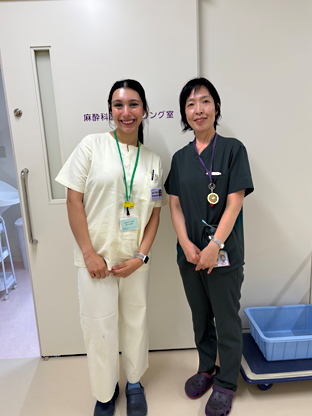 My time at Juntendo University proved to be an invaluable experience as a medical student.
My time at Juntendo University proved to be an invaluable experience as a medical student.
During my time at the department ofanaesthesiologyand pain medicine, I was welcomed by all members of the staff, and students and made to feel as though I was an important part of the team - going out of their way to explain topics to me, to ensure my understanding and learning.
Observing at Juntendo University Hospital allowed me to see a range of different procedures and different approaches toanaesthesiathat I previously did not have exposure to, and so I was able to learn and take away lots from each day. Some of the highlights of my time here involved seeing complex thoracicanaestheticcases, andspecialisedpaediatricanaesthesia.
All ofthis together has helped me build on my existing knowledge and gain a greater appreciation of not onlyanaesthesiapractice in Japan, but what it means to be ananaesthesiologistat aninternationallvrecognisedinstitute.順天堂大学での時間は、医学生としてかけがえのない経験となりました。
麻酔科・疼痛内科に在籍していた間、私はスタッフ全員と学生に歓迎され、まるでチームの重要な一員であるかのように感じさせられました。
順天堂大学医学部附属病院で観察することで、これまで触れることのなかったさまざまな手順やさまざまな麻酔アプローチを見ることができ、毎日から多くのことを学ぶことができました。ここで過ごした時間のハイライトには、複雑な胸部麻酔症例や専門的な小児麻酔の診察が含まれていました。
これらすべてが相まって、私は既存の知識をさらに発展させ、日本での麻酔実践だけでなく、国際的に認められた機関で麻酔科医であることの意味についてより深く理解することができました。(自動翻訳)Krishnan Sukumaran Ajit
研修期間:2025年7月8日~7月18日
所属:University of Cambridge医学部5年
国籍:イギリス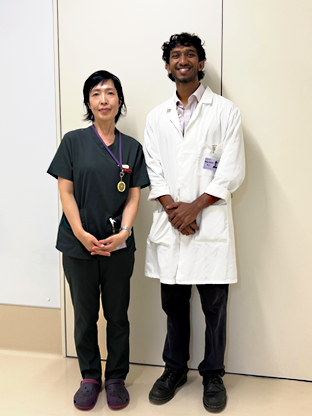 I recently completed a two-week placement with the Department ofAnaesthesiaat Juntendo University - I had a fantastic time and would highly recommend it to anyone interested inanaesthetics!
I recently completed a two-week placement with the Department ofAnaesthesiaat Juntendo University - I had a fantastic time and would highly recommend it to anyone interested inanaesthetics!
On the first day of myplacementI was given an induction by the internationalcentreat Juntendo university, later followed by a tour of the department by Professor Kawagoe who leads theprogramme. We discussed what my priorities were during my placement and Professor Kawagoe contacted all the relevant doctors to ensure that I would have the opportunity to experience everything I hoped to.
The team was so welcoming and kind - they were always willing to teach andmade an effortto make me feel as comfortable as possible. During my time at Juntendo, I was fortunate to seea number ofdifferent surgeries and during this observed different methods of induction, as well as a variety of spinal and peripheral nerve blocks. I was particularly struck by how efficiently theatres run compared to the UK - there is little wasted time and members of staff are generally incredibly diligent in performing their role within the team.
Differentanaesthetistsdo have slightly different ways of doing things, but generally I felt that the practice was much more consistent between different doctors than in the UK (e.g., the same drug cocktail is used for pretty much every patient having TIVA, and gas is used more sparingly.) During intubation it was also standard for allanaesthetistsat Juntendo to use a video laryngoscope, which is currently not the norm in the UK.
It was also interesting to see some of the newer technology that is used for some operations in Japan. One such example of this was augmented reality glasses whichutiliseCT scan data to construct a 3D overlay of the patient’s organs andtumoursto help surgeons better plan their approach to a surgery prior to the first incision. There was some suggestion that this technology might be adapted to help with the placement of lines and blocks inanaestheticsin the future.
In addition to operating theatres, I was fortunate to spend some time in ICU and pain clinic. I particularly enjoyed pain clinic, which I had not had a chance to visit as a medical student in the UK. Here I sawa number ofultrasound and X-ray guided root blocks performed for the management of chronic pain. I also saw one patient receive a trial of spinal cord stimulation - this is awell establishedtreatment in Japan, but in theUKit remains quite uncommon. Particularly in pain clinic I found that the doctors were very keen to teach and used both models and textbooks to illustrate the theory to me before I saw the actual procedures. This was invaluable and I was very touched by the effort they made to make sure I got the most out of my time there.
Overall, this was a thoroughly enjoyable and educationalelectiveand I feel very grateful to the JuntendoAnaesthesiadepartment for facilitating this. I would urge anyone that has an interest inanaesthesiaand/or visiting Japan to apply for this electiveprogramme!私は最近、順天堂大学麻酔科での2週間の実習を終えました。 素晴らしい時間を過ごしたので、麻酔に興味のある人には強くお勧めします。
実習初日は順天堂大学の国際センターで説明を受け、その後、川越教授が率いる学科を見学しました。私たちは、実習中に私の優先事項について話し合い、川越教授は、私が望むすべてのことを経験する機会を持てるように、関係するすべての医師に連絡を取りました。
チームはとても歓迎的で親切で、いつも喜んで教えてくれて、私ができるだけ快適に過ごせるように努力してくれました。順天堂在籍中、私は幸運にもさまざまな手術を見ることができ、その間にさまざまな導入方法や、さまざまな脊髄神経ブロックや末梢神経ブロックを観察しました。特に、英国と比較して劇場の運営効率の良さに感銘を受けました 。無駄な時間はほとんどなく、スタッフは一般的にチーム内で自分の役割を果たすのに信じられないほど熱心です。
麻酔科医によってやり方は若干異なりますが、一般的には英国よりも医師によってはるかに一貫していると感じました(たとえば、TIVAのほぼすべての患者に同じ薬のカクテルが使用され、ガスの使用は控えめです)。挿管中は、順天堂のすべての麻酔科医がビデオ喉頭鏡を使用することも標準でしたが、これは現在英国では標準ではありません。
また、日本で一部の業務に使用されている新しい技術のいくつかを見るのも興味深いことでした。その一例が拡張現実メガネで、CTスキャンデータを利用して患者の臓器や腫瘍の3Dオーバーレイを構築し、外科医が最初の切開前に手術へのアプローチをより適切に計画できるようにした。この技術は、将来的に麻酔薬におけるラインやブロックの配置に役立つように適応される可能性があるという提案がありました。
手術室に加えて、幸運にもICUとペインクリニックで時間を過ごすことができました。英国の医学生として訪れる機会がなかったペインクリニックを見ることは特に楽しかったです。ここでは、慢性疼痛の管理のために実行された超音波およびX線ガイド下ルートブロックを多数見ました。また、ある患者が脊髄刺激療法の試験を受けているのを見ましたが、これは日本では確立された治療法ですが、英国では依然として非常にまれです。特にペインクリニックでは、医師たちが教えることに非常に熱心で、実際の手順を見る前にモデルと教科書の両方を使って理論を説明していることがわかりました。これはかけがえのないもので、そこでの時間を最大限に活用するために彼らが行った努力にとても感動しました。
全体として、これは非常に楽しく、教育的な選択科目であり、これを促進してくれた順天堂麻酔科にとても感謝しています。麻酔に興味のある方や日本への訪問に興味がある方は、ぜひこの選択科目に申し込んでください。(自動翻訳)
- Heidelberg Universityの医学生が研修しました
-
Muhammad Mujtaba Siddiqi
研修期間:2025年5月20日~5月30日
所属:Heidelberg University医学部5年生
国籍:ドイツClinical Observership Experience at the Department of Anesthesiology and Pain Medicine of Juntendo UniversityHospital
My clinical observership at Juntendo University Hospital started in the Department of Anesthesiology and Pain Medicine. On the first day, I was wholeheartedly greeted by the Chair Anesthesiologist, Dr. Kawagoe, in her office as she showed me around the operating facilities. During my time in her department, I was partnered with another Anesthesiology attending doctor, who extensively answered all of my questions and concerns.
My observation was mainly focused on the surgical preparation of patients. What I found particularly intriguing was the number of regional anesthesias Juntendo University performs on patients to achieve the best postoperative outcome. For example, performing an additional block in thoracic surgeries which is uncommon in Germany, which however leads to better postoperative outcome.
During the procedures I always felt included in the process, and like a recognized member of the operating room - something that is not self-evident in other hospitals.
The Anesthesiology Department allowed me to explore as many surgeries as I pleased which in turn enabled me to discover different challenges an anesthesiologist faces during surgery, for instance transesophageal echocardiography (TEE) in cardiac surgeries.
Last but not least I am very grateful for arrangements being made by Dr. Kawagoe for receiving insights in Obstetric Anesthesia, Intensive Care and Pain Medicine as these areas were of great interest to me.
All in all, my short yet highly organised observership at the Department of Anesthesia was an eye-opening, intercultural experience, which I hope other international students get to witness themselves.順天大学病院麻酔科および疼痛医学科での臨床オブザーバーシップ体験
私の順天大学病院での臨床オブザーバーシップは、麻酔科および疼痛医学科から始まりました。初日、私は麻酔科の主任教授である川越先生に心から迎えられ、彼女のオフィスで手術施設を案内してもらいました。麻酔科での時間、私はもう一人の麻酔科医とペアになり、彼は私の質問や懸念に対して広範に回答してくれました。私の観察は主に患者の手術準備に焦点を当てていました。特に興味深かったのは、順天大学が最良の術後結果を得るために患者に行う局所麻酔の数です。例えば、ドイツではあまり一般的ではない胸部手術での追加ブロックの実施が、しかしより良い術後結果につながります。
手術の間、私は常にプロセスに参加していると感じ、オペ室の認められたメンバーとして扱われていると感じました。これは他の病院では自明ではありません。麻酔科は、私が好きなだけ手術を見学させてくれたため、手術中に麻酔科医が直面するさまざまな課題を発見することができました。たとえば、心臓手術における経食道心エコー検査(TEE)などです。最後に、川越先生が行ってくれた分娩麻酔、集中治療、疼痛医学に関する見識を得るための手配に深く感謝しています。これらは私にとって非常に興味深い分野でした。全体として、麻酔科での短いですが非常に組織的な観察経験は、目を見張る異文化体験であり、他の国際的な学生たちも自分自身で目撃できることを願っています。(自動翻訳)
- Brigham and Women’s Hospital,USの麻酔科専攻医とUniversity of Greifswald, Germanyの医学生が1か月研修しました。
-
Welcome to our department
2025年3月4日から約1か月間ふたりの研修生が(麻酔科専攻医と医学部6年生)が滞在していました。
Kareem El-Tayeb(麻酔科専攻医4年目)は毎年恒例のBrigham and Women’s Hospital, Harvard University, US,から
LeonardScheuer(医学部5年生), University of Greifswald, Germanyです。
協力していただいた先生方ありがとうございました。
研修を終えてという題名で寄稿してくれました。
Kareem El-Tayeb
PGY-4| Department of Anesthesiology, Perioperative, and Pain Medicine, Brigham and Women’s Hospital Harvard University, US, 2025年3月4日- 2025年3月30日
During my one-monthobservershipat Juntendo University’s Anesthesia Department, I had a truly wonderful experience. From the moment I arrived, everyone was incredibly warm and welcoming, making my time in the department both educational and enjoyable. It was a privilege to work alongside such skilled professionals and witness firsthand the expertise of the department. I deeply appreciated the opportunity to observe and learn from my Japanese colleagues, gaining valuable insight into the unique aspects of anesthesia practice inJapan.Oneof the most fascinating aspects of my time at Juntendo was seeing the differences between anesthesia practices in Japan and the United States. For example, thoracic epidurals are placed laterally, likely due to Japan’s lower average BMI. TIVA is the predominant anesthetic technique compared to the more frequent use of inhalational agents in the U.S. The workflow in Japan is exceptionally smooth, with patients going directly to the operating room for IV placement rather than through a preoperative area. Additionally, the recovery process is notably efficient, with shorter PACU stays than in the U.S. I also observed the widespread use of IV patient-controlled analgesia (PCA) for post-operative pain management. These differences provided a valuable perspective on how anesthesia is tailored to different patient populations and healthcare systems, and I am grateful for the opportunity to have been part of such a talented team. I would highly recommend the rotation at Juntendo University to any who are interested.
順天堂大学麻酔科での1か月の観察期間中、私は本当に素晴らしい経験をしました。到着した瞬間から、誰もが非常に温かく歓迎してくれて、麻酔科での時間は勉強になると同時に楽しいものでした。このような熟練した専門家と一緒に働き、麻酔科の専門知識を直接目撃できたことは光栄でした。日本の同僚を観察し、彼らから学ぶ機会に深く感謝し、日本の麻酔診療のユニークな側面について貴重な洞察を得ることができました。 順天堂での私の最も興味深い点の1つは、日本と米国の麻酔診療の違いを目にしたことです。たとえば、胸部硬膜外麻酔は横向きに配置されますが、これはおそらく日本の平均BMIが低いためです。米国では吸入剤がより頻繁に使用されていますが、TIVAは一般的な麻酔法です。日本のワークフローは非常にスムーズで、患者は術前エリアを経由するのではなく、IVを配置するために直接手術室に行きます。さらに、回復プロセスは著しく効率的で、PACU滞在期間は米国よりも短くなっています。また、術後疼痛管理にIV患者自己管理鎮痛法(PCA)が広く使用されていることも観察しました。これらの違いは、麻酔がさまざまな患者層や医療制度に合わせて調整される方法について貴重な視点を提供してくれました。このような優秀なチームの一員になれた機会に感謝しています。興味のある方には、順天堂大学での研修を強くお勧めします。(自動翻訳)Leonard Scheuer
研修期間:2025年3月4日- 2025年4月1日
After a recommendation fromcolleaguesI joined the Juntendo UniversityObservershipProgram for four weeks in the Department for Anesthesia and Pain Medicine. On the first day we were greeted by the International Center, shown around the OR by an attending and introduced to the department director personally to talk about our learning goals. In the following days we spend our time observing various operations and inductions, experienced the ICU as well as the Pain Clinic and met a lot of surgeons, anesthesiologists and other students.
所属:University of Greifswald身分:医学部5年生 国籍:ドイツ
In many ways, Japanese medicine is very similar to that in Germany: the OR looks familiar,anesthesiologistssedate patients and standard operations are performed. However, the differences are what made this internship so fascinating. Most patients walk into the OR by themselves – unlike in Germany, where everyone is transported by bed. Digitalization is also quite advanced, particularly in documentation, patient identification and personal communication with smartphones being used for all these purposes. Another intriguing aspect were the scrubs. In my hospital in Germany, everyone in the OR wears green, whereas here, students, nurses, surgeons, anesthesiologists, and auxiliary staff are easily distinguished by the color of their scrubs. As a student, I really appreciated this, as it helped me understand the routines and organization better.
For me, however, the biggest difference was the overall atmosphere and attitude. The surgeons patiently wait in the room until patient and anesthesia team are ready and escort the patient to the recovery room afterward instead of arriving at the last possible second and rushing out after the last suture is placed. Even after hours of work, the atmosphere remained friendly and respectful. Doctors always took the time to answer our questions patiently, and no one frowned upon us students for observing the operation or walking around.
My time in Tokyo was one of the most educational and amazing experiences I had in medicine so far and would recommend it to anyone looking for a well-organized and informative internship. A big thanks to Dr. Kawagoe and her team, as well as the International Center, for my time at Juntendo University.
同僚の勧めで、順天堂大学麻酔科・疼痛科の4週間の研修プログラムに参加しました。
初日は国際センターの出迎えを受け、担当医に手術室を案内してもらい、部門長に個人的に紹介され、学習目標について話し合いました。その後の数日間は、さまざまな手術や導入を観察し、ICUやペインクリニックを体験し、多くの外科医、麻酔科医、他の学生に会いました。
多くの点で、日本の医療はドイツの医療と非常に似ています。手術室は見慣れたもので、麻酔科医が患者を鎮静化し、標準的な手術が行われます。しかし、その違いこそがこの研修をとても魅力的なものにしました。ほとんどの患者は自分で手術室に入ります。ドイツでは全員がベッドで運ばれますが。
デジタル化もかなり進んでおり、特に文書化、患者の識別、個人的なコミュニケーションではスマートフォンがこれらすべての目的で使用されています。
もう1つの興味深い点は、手術着です。私がドイツで勤務していた病院では、手術室の全員が緑色のスクラブを着用していましたが、ここでは、学生、看護師、外科医、麻酔科医、補助スタッフはスクラブの色で簡単に見分けることができます。学生として、私はこれがルーチンや組織をよりよく理解するのに役立つので、本当にありがたかったです。
しかし、私にとって最大の違いは、全体的な雰囲気と態度でした。外科医は、患者と麻酔チームの準備ができるまで辛抱強く部屋で待機し、その後患者を回復室に案内します。最後の縫合が終わった後に急いで出て行くのではなく、ぎりぎりに到着することはありません。何時間も働いた後でも、雰囲気は友好的で敬意に満ちていました。医師は常に私たちの質問に辛抱強く答えてくれましたし、手術を見学したり歩き回ったりする私たち学生を誰も嫌がりませんでした。
東京での私の時間は、これまでの医学で経験した中で最も教育的で素晴らしい経験の1つであり、よく組織された有益なインターンシップを探している人にはお勧めです。順天堂大学での滞在を可能にしてくれた川越先生とそのチーム、そして国際センターに心から感謝します。(自動翻訳)
- 河邉 千佳 カンボジア・プノンペン Sunrise Japan Hospital 麻酔出張報告 2024/7/7-15
-
2024年7月7日から15日の1週間、カンボジアの首都プノンペンにあるSunrise Japan Hospital(SJH)に麻酔出張に行って参りました。きっかけは、3月に大学の小児外科の送別会に参加した際に、 SJHの院長・岡和田学先生(元・当院小児外科医)に再会し、病院の様子を伺って興味を持ったことでした。ちょうどSJHが順天堂医院と提携をする話が持ち上がっていた時期で、当科の川越教授にも話したところ、「ぜひ行って、様子を見てみてください」と快諾をいただきました。大学の研修医の先生たちもSJH研修のトライアルで2週間滞在する予定で、私も同時期に行くことになりました。家族も帯同する方も多いようで、私も子供と実母を連れての旅になりました。
入国までの手続きは、病院の日本事業部の方がとても親切に手厚くサポートしてくださったので、全く不安なく出発当日を迎えることができました。私たちはベトナム経由でプノンペンに入り、ここまではスムーズでしたが、入国時のビザ申請所と入国審査は非常に混雑しており、長い時間を要したために疲弊しました。しかし、空港を出るとすぐに病院からのお迎えがあり、案内されたサービスアパートメントも広く清潔で、全員がほっとしました。
SJHは朝7時半から、医師全員による勉強会とER症例提示のカンファレンスがあり日本人医師とカンボジア人医師と英語で活発に議論が行われておりました。同じ時期にS J Hと日本内視鏡外科学会が共同で行っているSurge Bridgeプロジェクトより内視鏡外科の先生が 2名いらしていて、日本のロボット手術の紹介をしておりました。手術は9時半入室で、子供から大人まで幅広く行われており、月曜から木曜の間で8件の麻酔(うち1件は脊椎麻酔、1件は静脈麻酔)を担当しました。SJHの麻酔科には普段3人の麻酔科医が所属しておりますが、1人は日本で研修中のため、残りの2名(マカラ先生、ビドゥ先生)と麻酔看護師 1名(セタさん)で麻酔していました。私は麻酔と彼らの教育に携わる形で参加しました。日本で採用されている薬剤とは異なり、特にレミフェンタニルがなかったため、硬膜外麻酔や神経ブロック、セボフルランに頼る麻酔になり、どの麻酔方法が適しているかと頭をフル回転で取り組みました。ブリディオンは日本から輸入がされていますが、高価なためあまり使用されておらず、久々にアトワゴリバースをしました。また、小児の仙骨硬膜外麻酔や腹部神経ブロック、声門上器具については、あまり馴染みがないようで、エコー下の仙骨硬膜外麻酔と神経ブロックを一緒に動画を見ながら教えました。後日、マカラ先生から「仙骨硬膜外麻酔や声門上器具がうまくできた」と報告をいただき、非常に嬉しかったです。
カンボジアでは、ポルポト時代の影響で教育を十分に受ける機会を長く失われていたこともあり、医学部に進むためには多くの学生が海外に行くようです。国内での麻酔教育はあまり充実しておらず、数少ない教育施設で働くことは非常に競争率が高いようです。日本の麻酔科医が当然のように受けている教育が、カンボジアでは当たり前でないことに衝撃を受け、改めて自分が恵まれた環境にいることを知りました。ただ医師たちは英語が堪能なので、ネットやメディアなどを使用すれば一定の教育が可能だと思う一方で、やはり実際に一緒に麻酔を行うことで最も教育効果があるとも感じました。
病院以外の時間は、日本人とカンボジア人の先生方、研修医の先生、SJH事務所の日本人スタッフの方々と、カンボジア料理やフランス料理などディナーを楽しみました。アパートメントでは毎朝、選んだ朝食をスタッフの方が運んでくださるのでとても快適でした。また、アプリによるタクシー配車や食事のデリバリーも充実しており、日本のイオンモールがプノンペンに3店舗もあるため、日本食にも困ることがありませんでした。子供も現地のサマースクールに参加し楽しんだようです。このように、スタッフの方が手厚く生活をサポートしてくださったおかげで、カンボジアの急成長とトゥクトゥクで感じるアジアの熱気の中で、やりがいのある仕事をさせて頂けるという贅沢な機会となりました。当科から定期的にスタッフを派遣するなどして、若い先生方にも視野を広げてもらえると嬉しいですし、カンボジア人の先生たちも刺激ある時間を過ごせるとお互いに良い経験になると思いました。素晴らしい機会をいただき、 SJHの岡和田先生はじめ、SJHの先生方やスタッフの皆様、当科の教授、麻酔科スタッフの皆様に誠に感謝申し上げます。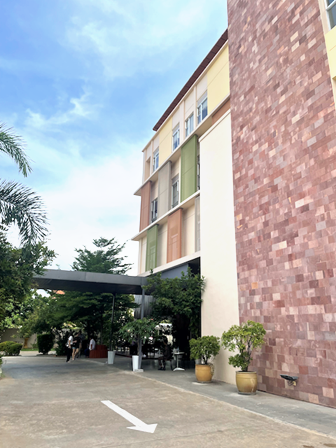 Sunrise Japan Hospital正面玄関
Sunrise Japan Hospital正面玄関 手術室でセタさん(左)と
手術室でセタさん(左)と
マカラ先生(右)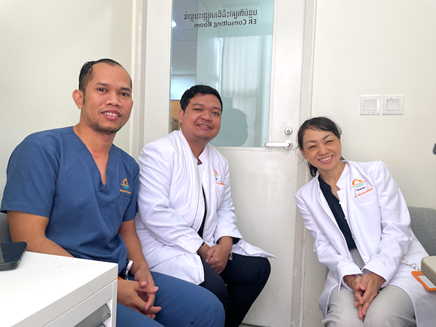 ヴィドゥ先生(左)と
ヴィドゥ先生(左)と
マカラ先生(真中)と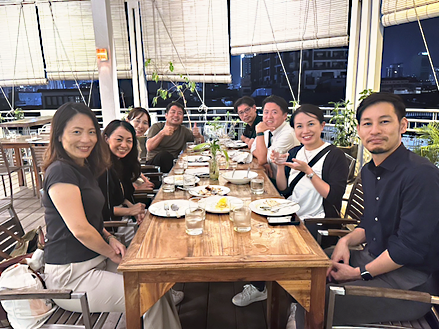 現地スタッフと岡和田先生、
現地スタッフと岡和田先生、
訪問医師でディナー